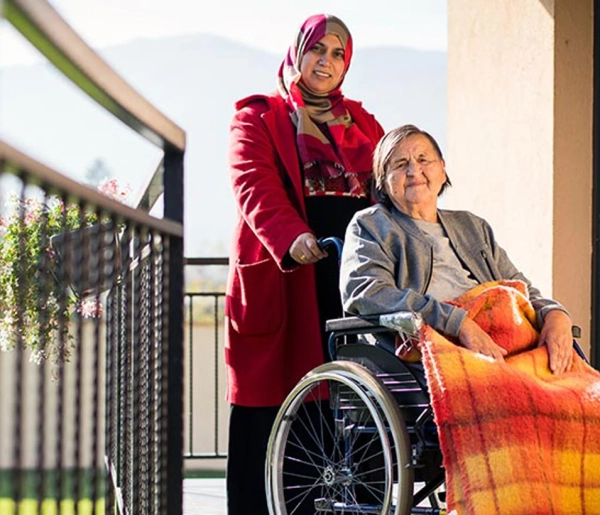Rehabilitation and long-term care are essential components in the lives of disabled or ill individuals worldwide. Patients enter these programs for various reasons, including sudden injury, trauma, mental disorders, or old age.
Rehabilitation and long-term medical care cater to patients at different stages of the recovery process.
Rehabilitation, also known as rehab, is a process through which physically or mentally compromised people regain their health and can begin to function as regular members of society once again. Rehabilitation can help people who have experienced a stroke, mental trauma, or physical injury.


- Mechanical Ventilation Program
- — Weaning Program
- — Long Term Ventilated Patients
- Post Acute Rehabilitation
- — Neuro Rehabilitation
- — Musculoskeletal Rehabilitation
- — Post Surgeries Rehabilitation
- — Road Traffic Accident
- Pulmonary Rehabilitation
- Speech and Language
- Neuromuscular Rehabilitation
- Central Nervous System Anomalies
- Long Term Care of Cardiac
- Pediatric Transitional Care
- Post Acute Care
- Outpatient Services
- Home Healthcare Services
Cambridge Medical & Rehabilitation Center (CMRC) is a leading provider of long-term care and rehabilitation services in the United Arab Emirates and Saudi Arabia. Our state-of-the-art facilities are dedicated to enhancing the quality of life for individuals through a holistic and interdisciplinary approach.
Our long-term care services cater to patients of all ages, offering personalized rehabilitation plans developed by our team of skilled therapists, nurses, and experienced physicians. We prioritize family involvement in the treatment process, ensuring a supportive environment that fosters recovery and growth.
Experience comprehensive care with regular follow-ups, care coordination, and community support at CMRC—where your recovery journey feels like #YourSecondHome.
Types of Rehabilitation
Rehabilitation falls into three primary categories:
Occupational Rehabilitation Therapy
This is the first form of rehabilitation therapy and aims to help injured individuals regain the skills necessary to carry out regular daily activities, particularly those related to their jobs.
Occupational therapists are trained professionals responsible for this process; they actively work with patients, teaching them how to perform both simple and complex tasks.
Occupational therapists strive to help patients regain the ability to physically perform enough tasks to re-enter the workforce. This focus distinguishes them from experts who practice other forms of rehabilitation therapy.
Physical Rehabilitation Therapy
Physical therapy is when a practiced professional, called a physiotherapist, provides movement therapy to patients who have trouble moving around on their own. A physiotherapist can help people walk again, eat by themselves, and do other simple things related to daily life. Physical therapy centers on strengthening depleted muscles, improving cognition, and enabling independent activity.
The first step involved in physical therapy is the examination and evaluation of the patient’s current stature, after which a set of exercises are decided; these exercises are usually assisted and performed by the patient with help from the physiotherapist. Some patients may also receive medicinal treatment if needed, including painkillers.
There are many tools and machines involved with physiotherapy, such as treadmills, a pedal exerciser, and ellipticals. These are all readily available at inpatient rehabilitation centers, which is why the family members of the patient generally prefer to let them stay there instead of at home, where these nursing facilities may not be readily available.
Speech Rehabilitation Therapy
Speech rehab therapy is for those patients who have, due to injury or trauma, lost their ability to speak fluently. A qualified professional called a speech therapist can help such individuals regain their speaking ability by regularly practicing drills with them and pushing them to do their best.
Medication may or may not be involved; however, for the most part, regaining one’s speech depends upon the amount of time spent practicing with a professional speech therapy practitioner.
Inpatient vs. Outpatient Rehabilitation
There are two methods of providing care to rehab patients:
Inpatient Rehabilitation
Inpatient treatment is provided to those who are admitted to the rehabilitation hospital. This treatment includes receiving round-the-clock therapy and care and is important for patients who have suffered from serious injuries and traumas, including a stroke, brain damage, and spinal cord injury, to name a few.
Before being discharged, these patients may require full-time intensive care and even require medical machinery, like a ventilator, in case of emergencies; for this reason, they are not allowed to stay home and visit the rehab center for scheduled appointments. Instead, they must live in-house where they receive personal care until their recovery is complete.
Outpatient Rehabilitation
This is the second form of care provided by rehab centers and refers to patients who receive care without needing to permanently stay at the hospital. They regularly visit the rehab clinic or center and have scheduled appointments with human-service therapists who can help them improve their speech, overcome any psychological problems, deal with mild pain issues, and more.
What is Long Term Care ?
Long term care (LTC) is when a person, particularly one who is physically or mentally weak, requires constant assistance when performing regular acts, such as eating, drinking, and getting dressed. They may experience such problems even after successfully completing rehab. While, for the most part, they are stable, they will still need help in some things.
Long term care is generally provided by a trained professional, like a nurse, who can help them with personal care and activities of daily living. Apart from people who have mild trouble doing things, those with permanent illness or disability can seek skilled care from a home health care provider. There are also many long-term care insurance policies in place, that cover those needed rehabilitation services
Long Term Care vs. Rehabilitation
Long-term care is generally required for people who have gone through rehab and require care. Such people, although much better than they were before, would benefit from nursing care and related support services. Skilled nursing goes a long way; these people need assistance, or else they won’t be able to do basic things, sometimes even as simple as feeding themselves.
Rehabilitation, on the other hand, is when a person who needs professional support is admitted into a center, like a rehabilitation hospital, where they receive care that will help them recover. This care is significantly different from that offered by a long term care facility.
Where long term care offers people help with performing simple chores which are a part of regular daily life, like taking medicines or bathing, rehab centers provide services like skilled nursing as well as physiotherapy, hydrotherapy, and occupational therapy. Both are associated with healthcare but have a solution for problems faced at different stages of the recovery process.
Transitional Care
The period between transitioning from one form of care to another is called transitional care and is provided to those shifting from a rehabilitation hospital to a nursing home or even back to their own home. It also applies to those shifting from one caregiving unit to another unit under the same roof. Whatever the case, appropriate arrangements must be made for shifting patients.
Transitional care includes setting up a new environment for the patient, especially if they are shifting from a hospital back to their home. The patient may require special seats, for example, to support their backbone; making sure this is available in the new environment is an example of a task that transitional care professionals are expected to do.
Who Requires Rehabilitation and Long Term Care?
Rehabilitation and follow-up long-term care is required by many people around the world; stroke patients, post-ICU patients, senior citizens, physically or mentally disabled people, and ventilated patients are relevant examples.
Those patients who require immediate medical attention, such as those with an ongoing illness, should stay in a rehabilitation hospital. This is because they may require emergency care that only a trained doctor can provide; some things are beyond the scope of a home nurse and could get out of hand if not dealt with correctly. Rehab hospitals also have all the tools needed to successfully deal with the emergency; you can find ventilators, appropriate emergency medication, healthcare machines, and much more without any hassle.
Everything needed for treatment is available under one roof, which can’t be said for nursing facilities, including old age homes or personal residences.
Nursing Homes vs. Long Term Care
Nursing homes and long term care are two different things. Generally, long term care is given by professional nurses who visit the patient’s home and supervise them as they perform mundane tasks, often providing them with the assistance they need in completing them.
A nursing home, on the other hand, is a professional adult day care center; these centers take care of their residents round the clock and expect them to follow a strict schedule and set of rules that would not be applicable within one’s own home. Nursing homes are generally intended for senior citizens, or those who require intensive care yet do not have any family members to stay by their side through it all.
Rehabilitation hospitals are great alternatives to nursing homes as they can provide the care needed by stroke patients, paraplegics, and patients with speech problems, senior citizens, and others like them. Most rehab centers are complete with health insurance, nursing facilities, and can cater to people over age 65 just as well as a nursing home could.